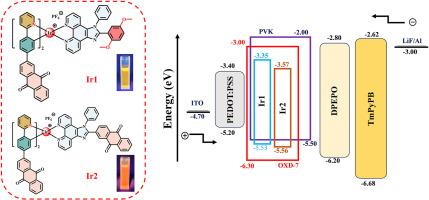Orange iridophosphors featuring electron-withdrawing bis-anthraquinonyl groups for solution-processed OLEDs
IF 4.2
3区 工程技术
Q2 CHEMISTRY, APPLIED
引用次数: 0
Abstract
The synthesis and characterization of two novel orange emissive cationic iridium(III) complexes (Ir1 and Ir2) are reported. Both complexes are coordinated with cyclometalating ligands consisting of strongly electron-withdrawing anthraquinone and π-conjugated phenylpyridine units. Additionally, electron-donating methoxy group and electron-withdrawing anthraquinone are incorporated into the ancillary ligands. Ir1 and Ir2 are ionic solids with excellent stability. They exhibit orange phosphorescence at room temperature, with full width at half maximum (FWHM) exceeding 100 nm, which enables high-quality white-light emission with a high CRI, and lifetimes of 7.77 and 6.28 μs in solution, respectively. These cationic iridium(III) complexes can be processed via solution spin-coating and used as phosphorescent dyes for the fabrication of organic light-emitting diodes (OLEDs). The device doped with 5 wt% Ir2 showed the best performance, achieving maximum external quantum efficiency (EQEmax) of 1.5 %, peak luminance of 660 cd/m2, respectively.

溶液处理oled中具有吸电子双蒽醌基的橙色环烯磷化合物
报道了两种新型橙色发射型阳离子铱(III)配合物(Ir1和Ir2)的合成和表征。这两种配合物均与环金属化配体配位,配体由强吸电子蒽醌和π共轭苯吡啶单元组成。此外,在辅助配体中加入了供电子的甲氧基和吸电子的蒽醌。Ir1和Ir2是稳定性优异的离子固体。它们在室温下呈现橙色磷光,半峰全宽(FWHM)超过100 nm,具有高质量的白光发射,具有高显色指数,在溶液中的寿命分别为7.77和6.28 μs。这些阳离子铱(III)配合物可以通过溶液自旋涂层处理,并用作制造有机发光二极管(oled)的磷光染料。掺量为5 wt% Ir2的器件表现出最佳性能,最大外量子效率(EQEmax)为1.5%,峰值亮度为660 cd/m2。
本文章由计算机程序翻译,如有差异,请以英文原文为准。
求助全文
约1分钟内获得全文
求助全文
来源期刊

Dyes and Pigments
工程技术-材料科学:纺织
CiteScore
8.20
自引率
13.30%
发文量
933
审稿时长
33 days
期刊介绍:
Dyes and Pigments covers the scientific and technical aspects of the chemistry and physics of dyes, pigments and their intermediates. Emphasis is placed on the properties of the colouring matters themselves rather than on their applications or the system in which they may be applied.
Thus the journal accepts research and review papers on the synthesis of dyes, pigments and intermediates, their physical or chemical properties, e.g. spectroscopic, surface, solution or solid state characteristics, the physical aspects of their preparation, e.g. precipitation, nucleation and growth, crystal formation, liquid crystalline characteristics, their photochemical, ecological or biological properties and the relationship between colour and chemical constitution. However, papers are considered which deal with the more fundamental aspects of colourant application and of the interactions of colourants with substrates or media.
The journal will interest a wide variety of workers in a range of disciplines whose work involves dyes, pigments and their intermediates, and provides a platform for investigators with common interests but diverse fields of activity such as cosmetics, reprographics, dye and pigment synthesis, medical research, polymers, etc.
 求助内容:
求助内容: 应助结果提醒方式:
应助结果提醒方式:


